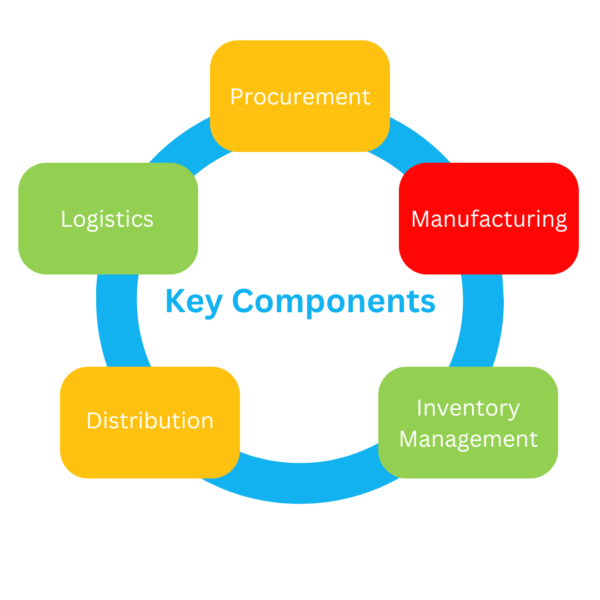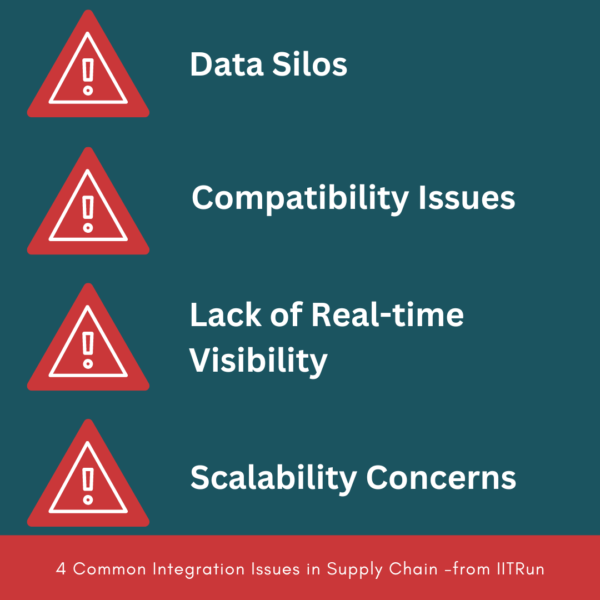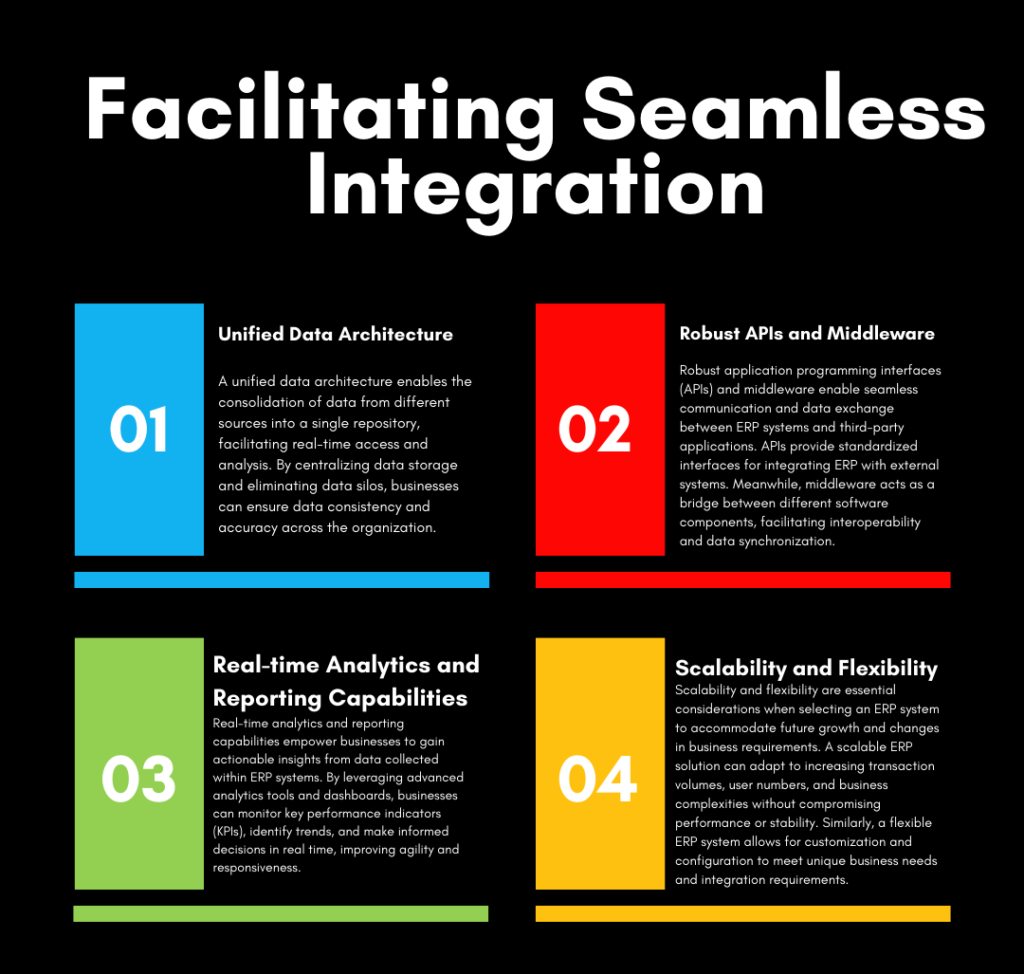
 In the realm of ERP systems, integration ties together disparate business processes and data streams across organizations. Picture a scenario where procurement, manufacturing, inventory management, distribution, and logistics seamlessly intertwine, driving operational excellence and propelling businesses forward. This is the power of integration within ERP systems—a power that promises efficiency and innovation in supply chain management.
In the realm of ERP systems, integration ties together disparate business processes and data streams across organizations. Picture a scenario where procurement, manufacturing, inventory management, distribution, and logistics seamlessly intertwine, driving operational excellence and propelling businesses forward. This is the power of integration within ERP systems—a power that promises efficiency and innovation in supply chain management.
However, this promise isn’t without its challenges. Businesses often face hurdles, such as disparate systems hindering communication, compatibility issues with different software versions, and difficulties in scaling to accommodate growth. Businesses must overcome these challenges if they want to unlock the full potential of ERP solutions and optimize their supply chain operations.
By adopting strategic integration approaches, engaging stakeholders, and leveraging emerging technologies such as the Internet of Things (IoT), Artificial Intelligence (AI), and blockchain, businesses can navigate the complexities of supply chain integration and pave the way to a future of innovation and efficiency.
Join us as we explore supply chain integration within ERP systems.
Understanding Integration in ERP
Supply chain integration is the process of connecting all parts of a supply chain to ensure efficient and effective communication, collaboration, and coordination.1 To do this, the organization connects different internal departments, along with linking suppliers, distributors, retailers, customers and other stakeholders in the supply chain. This way, the business ensures everyone is working towards the same goal while optimizing performance.
In the context of ERP, integration allows businesses to connect disparate business processes and data across different departments and functions. Integration entails the consolidation of information flow and the synchronization of activities to enable real-time visibility, efficient decision-making, and enhanced collaboration across the entire enterprise ecosystem.
Below are some key components:

Procurement:
Integration in procurement requires businesses to streamline the processes related to sourcing, purchasing, and supplier management. To do this, businesses need to conduct activities such as vendor selection, purchase order generation, contract management, and invoice processing. By integrating procurement functions within ERP, organizations can optimize sourcing decisions, negotiate better deals with suppliers, and ensure timely delivery of goods and services.
Manufacturing:
Manufacturing integration within ERP encompasses the coordination of production planning, scheduling, resource allocation, and quality control activities. For successful integration, businesses need to employ production processes with demand forecasts, optimize production schedules based on inventory levels, and track work-in-progress in real-time. Ultimately, integration in manufacturing enables organizations to improve production efficiency, minimize lead times, and respond swiftly to changes in market demand.
Inventory Management:
Inventory management integration focuses on optimizing inventory levels, reducing carrying costs, and improving inventory visibility across the supply chain. To ensure adequate stock levels while avoiding stockouts or overstock situations, businesses need to synchronize inventory data with procurement, production, and sales processes. By integrating inventory management within ERP, organizations can achieve better demand forecasting accuracy, optimize reorder points, and improve inventory turnover ratios.
Distribution:
Distribution integration entails the coordination of warehousing, order fulfillment, and logistics activities to ensure timely delivery of products to customers. It involves optimizing warehouse operations, managing order picking and packing processes, and coordinating transportation and delivery schedules. Integration in distribution enables organizations to enhance order accuracy, reduce order fulfillment cycle times, and improve customer satisfaction through faster delivery times and better shipment tracking capabilities.
Logistics:
Logistics integration within ERP encompasses the management of transportation, freight forwarding, and supply chain visibility activities. Such integration involves optimizing route planning, carrier selection, freight rates negotiation, and tracking shipment status in real-time. At the end of the day, integration in logistics enables organizations to minimize transportation costs, improve delivery reliability, and enhance supply chain agility by proactively addressing disruptions and delays.
As they understand the intricacies of integration within ERP systems and recognizing the pivotal role it plays in supply chain management, businesses can unlock new opportunities for operational and cost efficiency.
Common Problems in Supply Chains
Businesses often encounter a myriad of challenges that push them towards integration, many of which impede efficiency, productivity, and overall performance. Addressing these challenges is crucial for businesses to fully leverage the benefits of ERP solutions and optimize their supply chain operations. Additionally, it’s the first step towards a successful supply chain integration.

- Disparate Systems Hindering Communication and Efficiency
In many organizations, disparate systems and applications operate in isolation, leading to the formation of data silos. These silos create barriers to effective communication and collaboration between different departments and functions, resulting in inefficiencies, duplicated efforts, and data inconsistencies. For instance, sales data stored in a separate CRM system may not be readily accessible to the finance department for revenue forecasting, leading to discrepancies in financial reporting. Integrating these disparate systems within ERP helps break down silos by centralizing data storage and enabling seamless data exchange across the organization.
- Issues Arising from Different Software Versions or Platforms
Compatibility issues arise when integrating legacy systems or third-party applications with the ERP platform, particularly when they operate on different software versions or platforms. Mismatched data formats, incompatible APIs, and conflicting business logic can hinder the smooth flow of information among systems, leading to data errors, processing delays, and system crashes. To resolve compatibility issues, businesses need thorough testing, customization, and (sometimes) the development of middleware or connectors to facilitate data exchange among disparate systems while ensuring data integrity and system stability.
- Problems with Decision-making and Responsiveness
One of the critical benefits of ERP integration is real-time visibility into business operations, enabling stakeholders to access up-to-date information and make informed decisions promptly. However, many organizations struggle with achieving real-time visibility due to data latency, batch processing, or inadequate reporting capabilities. Without timely access to accurate data, decision-makers may rely on outdated information or even gut instincts, leading to suboptimal decisions and missed opportunities. Integrating ERP systems with advanced analytics tools, IoT sensors, and cloud-based platforms can enhance real-time visibility, enabling proactive decision-making and rapid response to changing market conditions.
- Difficulties in Accommodating Growth and Changes in the Supply Chain
As businesses expand and evolve, their ERP systems must scale accordingly to accommodate growing transaction volumes, new business processes, and changes in the supply chain. However, many legacy ERP systems lack the scalability and flexibility required to adapt to evolving business needs, resulting in performance bottlenecks, system downtime, and increased maintenance costs. Addressing scalability concerns involves migrating to cloud-based ERP solutions and adopting modular architectures. Additionally, businesses need to implement agile development methodologies to facilitate seamless upgrades, customization, and scalability without disrupting ongoing operations.
 Impact on Business Operations
Impact on Business Operations
While integration can help resolve many issues, the process poses some difficulties of its own, such as poor communication, inconsistent goals, and unexpected costs. Unfortunately, integration issues within ERP systems can have profound implications for various aspects of business operations, affecting efficiency, accuracy — and ultimately — customer satisfaction. Understanding the impact of these challenges is crucial for businesses to recognize the urgency of addressing integration issues and implementing effective solutions.
- Delays in Order Processing and Fulfillment:
Integration challenges often result in delays in order processing and fulfillment as information fails to flow seamlessly between different stages of the supply chain. For example, a delay in updating inventory levels due to integration issues may lead to stockouts or incorrect stock allocation, resulting in delayed order processing. These delays affect not only customer satisfaction, but also operational efficiency and revenue generation. By streamlining integration processes, businesses can minimize order processing times and improve overall operational agility.
- Increased Risk of Errors and Inaccuracies:
Integration issues contribute to a higher risk of errors and inaccuracies in data processing and transactional activities. For instance, manual data entry or batch processing of information among disparate systems can lead to data duplication, transcription errors, and mismatched records. These errors not only undermine data integrity, but also jeopardize decision-making processes based on inaccurate or incomplete information. By automating data exchange and implementing data validation checks within ERP systems, businesses can mitigate the risk of errors and ensure data accuracy throughout the supply chain.
- Inefficient Resource Allocation and Utilization:
Integration challenges often result in inefficient resource allocation and utilization across different departments and functions within an organization. For example, without real-time visibility into inventory levels and production schedules, businesses may overstock certain items while underutilizing resources in other areas of the supply chain. This leads to increased carrying costs, excess inventory, and suboptimal resource utilization, ultimately impacting profitability and competitiveness. By integrating ERP systems and implementing advanced analytics tools, businesses can optimize resource allocation, minimize waste, and improve operational efficiency.
- Customer Dissatisfaction Due to Delayed Deliveries or Incorrect Orders:
Perhaps the most significant impact of integration issues on business operations is customer dissatisfaction from delayed deliveries or incorrect orders. Customers expect timely delivery of products and services, and any disruption in the supply chain can lead to dissatisfaction, loss of trust, and damage to the brand reputation. More specifically, integration challenges such as inventory discrepancies, order processing errors, or logistics delays can directly impact the customer experience, leading to lost sales, increased customer support costs, and potential churn. By prioritizing integration efforts and investing in technologies that enable real-time visibility and order tracking, businesses can enhance customer satisfaction and loyalty while maintaining a competitive edge in the market.
Addressing Integration Issues with ERP
In the face of integration challenges, businesses may consider employing ERP. By addressing integration issues proactively through a strategic ERP approach, businesses can streamline operations, improve efficiency, and gain a competitive edge in the market.
- Importance of Selecting a Comprehensive ERP Solution:
Businesses must choose a comprehensive ERP solution if they want to address integration challenges effectively. A comprehensive ERP system consolidates various business functions — such as finance, manufacturing, procurement, and supply chain management — into a single integrated platform. This eliminates the need for multiple disparate systems, reducing complexity and streamlining data exchange processes across the organization.
- Features to Look for in an ERP System to Facilitate Seamless Integration:
To ensure seamless integration within ERP systems, businesses should look for the following key features:

Best Practices for Integration
Even with a quality ERP system, businesses need to ensure that their internal procedures are also solid. After all, implementing effective integration strategies within Enterprise Resource Planning (ERP) systems requires a systematic approach that takes various factors into account.
Namely, businesses need to consider existing systems, stakeholder involvement, implementation methodology, and ongoing monitoring. By following best practices for integration, businesses can mitigate risks, maximize benefits, and ensure the success of their integration initiatives.
- Conduct a Thorough Assessment of Existing Systems and Processes
Before embarking on an integration project, businesses need to conduct a comprehensive assessment of existing systems, processes, and data flows. This assessment helps identify integration points, data dependencies, and potential challenges that need to be addressed. By gaining a thorough understanding of the current state of affairs, businesses can develop a roadmap for integration that aligns with their strategic objectives and business priorities.
- Engage Key Stakeholders from Different Departments
Integration initiatives involve multiple stakeholders from different departments within the organization, including IT, finance, operations, sales, and marketing. Because of this, businesses must engage these key stakeholders early in the integration process to ensure alignment of goals, requirements, and expectations. As they foster collaboration and communication among stakeholders, businesses can gain valuable insights, address potential conflicts, and secure buy-in for the integration project.
- Implement a Phased Approach to Integration
Integration projects are complex, often involving multiple systems, processes, and dependencies. To manage complexity and minimize disruption to ongoing operations, businesses should adopt a phased approach to integration. This involves breaking down the integration project into smaller, manageable components or phases, each focusing on specific objectives or functional areas. By implementing integration in phases, businesses can prioritize critical integration points, minimize risks, and gradually transition to the new integrated environment without overwhelming stakeholders or resources.
- Continue Regular Monitoring and Performance Evaluation
Integration is an ongoing process that requires continuous monitoring and performance evaluation to ensure success and identify areas for improvement. Because of this, businesses should establish metrics, KPIs, and performance benchmarks to track the effectiveness of integration efforts and measure the impact on business outcomes. After all, regular monitoring allows businesses to identify issues, bottlenecks, and gaps in integration, so they can take corrective actions in a timely manner. By leveraging analytics, reporting tools, and feedback mechanisms, businesses can optimize integration processes, enhance efficiency, and drive continuous improvement.
 Future Trends and Technologies
Future Trends and Technologies
As technology continues to evolve rapidly, the future of supply chain integration within ERP systems is being shaped by emerging technologies that promise to revolutionize how businesses manage and optimize their operations. By staying on top of these trends and technologies, businesses can gain a competitive edge and prepare for the future of supply chain integration.
Internet of Things (IoT) for Real-time Tracking and Monitoring:
IoT technology involves connecting physical devices, sensors, and equipment to the internet, enabling real-time data collection, monitoring, and control. Additionally, IoT devices can be deployed throughout the supply chain, from manufacturing facilities and warehouses to transportation vehicles and retail stores. These devices can capture valuable data on asset location, condition, and performance, providing businesses with unprecedented visibility into their supply chain operations. By leveraging IoT data within ERP systems, businesses can optimize inventory management, track shipments in real-time, and proactively identify and address supply chain disruptions.
Artificial Intelligence (AI) for Predictive Analytics and Demand Forecasting:
AI-powered analytics and machine learning algorithms are transforming how businesses analyze and leverage data to make informed decisions. In supply chain integration, AI can be used to analyze historical data, customer behavior, market trends, and external factors to predict future demand and optimize inventory levels. By incorporating AI-driven predictive analytics into ERP systems, businesses can enhance demand forecasting accuracy, minimize stockouts, and reduce excess inventory costs. AI can also enable predictive maintenance of equipment and assets, improving operational efficiency and reducing downtime in manufacturing and logistics operations.
Blockchain for Secure and Transparent Transactions:
Blockchain technology offers a decentralized and immutable ledger system that enables secure and transparent transactions between parties without the need for intermediaries. In the context of supply chain integration, blockchain can enhance transparency, traceability, and trust throughout the supply chain as it provides a tamper-proof record of transactions and product movements. For example, blockchain can help track the provenance of raw materials, authenticate product authenticity, and ensure compliance with regulatory requirements. By integrating blockchain technology into ERP systems, businesses can streamline supply chain processes, reduce fraud and counterfeiting risks, and build trust among stakeholders.
The Importance of a Strategic Business
To close this discussion, we will explore a study from Janurary 2023 by Oubrahim and other authors to better understand the relationship among supply chain integration, digital transformation, and — as the study deems it — OSSCP (or overall supply chain performance).2
The study provides a questionnaire survey to international manufacturing companies based in Morocco, which received responses from 134 participants. Then, the study used the survey responses to assess reliability, validity, and structural relationships.
In the study, they found that digital transformation positively impacts both supply chain integration and OSSCP, with supply chain integration moderating the relationship between digital transformation and OSSCP. Namely, digital transformation positively impacts “internal, supplier, and customer integration” (section 7.2). Additionally, a successful supply chain integration ensures both a successful and sustainable supply chain.
Future research could explore these relationships across different sectors and countries, using objective performance measures to validate findings and uncover sector-specific implications. Additionally, examining the impact of digital transformation adoption on other sectors and exploring energy efficiency in sustainability assessments could provide further insights.
From this study, we can take away the fact that businesses striving for successful supply chain integration need to not only improve their processes, but also vamp up their agility and strategy. Take a look at this article to learn more: https://www.iitrun.com/from-vision-to-reality-unleashing-the-power-of-erp-goals-in-it-evolution-final-part/.
Conclusion
The journey towards ERP success hinges greatly on the seamless integration within the supply chain. As we’ve seen throughout this exploration, integration is not merely a technical checkbox, but a strategic necessity. Namely, supply chain integration serves as the backbone of ERP systems, enabling data flow, process synchronization, and collaboration across various functions and stakeholders. Without robust integration, ERP systems risk becoming siloed islands of information, unable to provide the comprehensive insights and efficiency gains that businesses seek.


 Impact on Business Operations
Impact on Business Operations Future Trends and Technologies
Future Trends and Technologies


